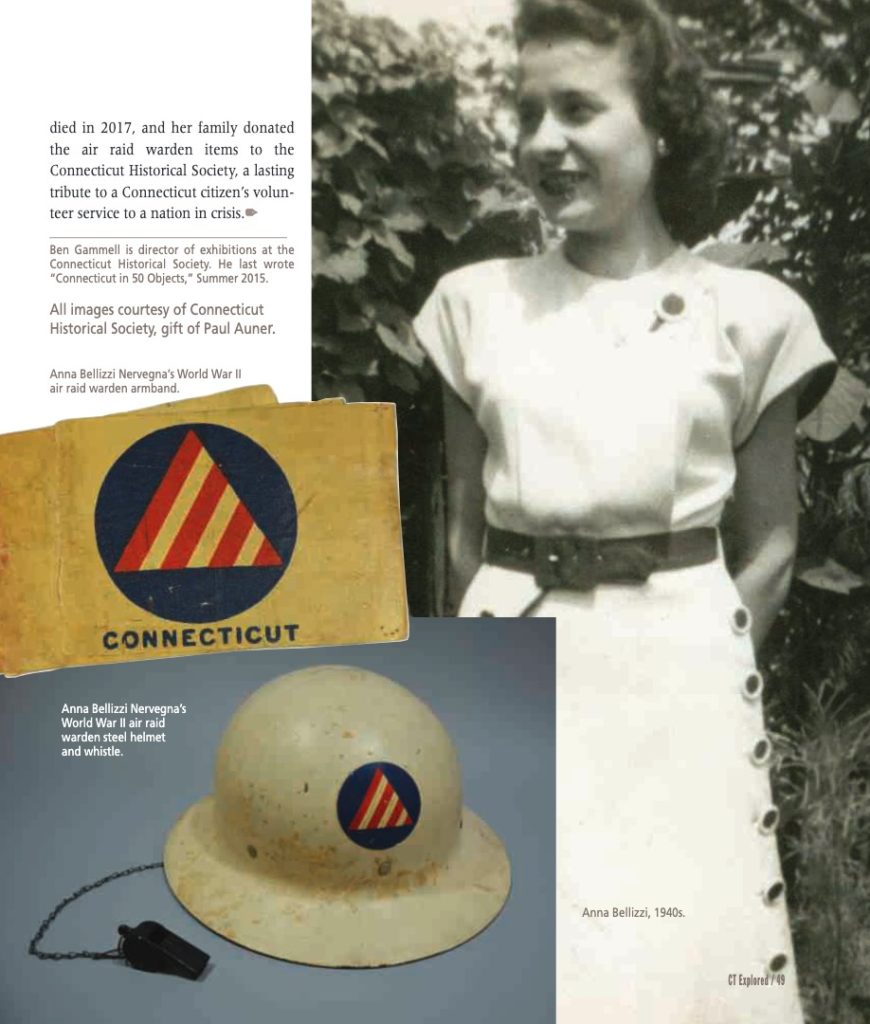(c) Connecticut Explored Inc. Fall 2020
Subscribe/Buy the Issue!
Three recent acquisitions to the Connecticut Historical Society collection bring to mind a time when ordinary citizens faced a global crisis and volunteered to protect their community. A steel helmet, a whistle, and an armband testify to the service of Anna Bellizzi Nervegna as a Hartford air raid warden during World War II.
In 1941 the Connecticut State Defense Council began preparing its citizens for the coming war. The council coordinated the work of U.S. government agencies and local defense councils. Activities included emergency response planning, scrap metal drives, surveys of agricultural production and water facilities, and an array of functions for which people could volunteer: bomb reconnaissance agents, fire watchers, nurses’ aides, messengers, auxiliary firefighters and police officers, drivers, chaplains, and more. Thousands of Connecticans volunteered for civil defense roles.
One important function was air raid warden. This was the first war in which an attack from the air was a real possibility. Connecticut’s east-coast location and the strategic importance of its defense industries put the state on high alert.
On the front of Bellizzi’s helmet and on her armband is the emblem of the Citizens Defense Corps, organized by the U.S. Office of Civilian Defense. Air raid wardens were responsible for enforcing blackouts during air raid warnings and drills and were designated as first-responders to neighborhood bomb attacks should they occur. Wardens were trained to “be at the scene of impact, size up the damage to property and to people, and report it through in the quickest time possible,” according to The Air Raid Warden in Connecticut, a 42-page manual published in 1942 by the Connecticut State Defense Council.
Bellizzi was born in San Basile, Italy in 1921, the daughter of Paul and Catherine Bellizzi, and came to the United States with her family in 1929 at age eight. She grew up in Hartford’s Parkville neighborhood, attended Hartford Public High School, and worked for Metropolitan Life Insurance for more than 35 years. In 1966 she married Luigi Nervegna, also from Italy, and they remained together until Luigi’s death in 2000.
As a volunteer air raid warden in her early 20s, Bellizzi patrolled a “sector” around her home on Francis Avenue. According to the warden’s manual, “He (or she, for many of them are women) is the civilian defense leader for his own particular neighborhood. He shows people what to do if air raids ever come. The warden steadies people, gives them confidence, makes them feel that they are being looked out for and not forgotten, and will be told what to do in an emergency and how to do it.”
The manual describes how a warden was to be equipped and why. “He must wear a steel helmet, and a translucent eye shade is a great protection, keeping out fragments of glass and shells and also the terrific amount of dust particles that are caused by falling masonry. Around his waist he has a small first aid kit, hung on a webbing belt; to his belt are generally attached his notebook and pencil and his pad of warden’s report forms. A shaded electric torch usually hangs from his belt, too. He wears an arm band showing that he is an air raid warden. Around his neck hangs a police whistle.” Wardens received weeks of training.
Middletown-born big band leader Tony Pastor wrote and released the catchy tune “Obey Your Air Raid Warden” in 1942. The song was a “deliberate attempt to mobilize popular culture in support of the war” effort, according to Wende V. Feller in Home Front Heroes (Greenwood Press, 2007). Available on YouTube, the lyrics say, “When you hear the sirens blow, Stop, look, and listen. … Dim the lights, Wait for information, Most of all, Obey your air raid warden.”
By late 1943 German air power had collapsed and was no longer deemed a threat, according to Robert Towne in “Civil Defense in Stamford: The Air Raid Warden System Through Two World Wars,” on StamfordHistory.org. Air raid defense activities began to relax. According to family members, Nervegna was proud of her role as a warden and took the job seriously, knowing that at the time many of her relatives had enlisted to fight in Europe and the Pacific. She died in 2017, and her family donated the air raid warden items to the Connecticut Historical Society, a lasting tribute to a Connecticut citizen’s volunteer service to a nation in crisis.
Ben Gammell is director of exhibitions at the Connecticut Historical Society. He last wrote “Connecticut in 50 Objects,” Summer 2015.
EXPLORE!
If you enjoyed this story, join us — Subscribe Today!
“A Sound They’ll Never Forget,” Fall 2020
Read more about Connecticut in World War II in our Fall 2020 issue and on our Connecticut at War TOPICS page.
Read more about immigration in Connecticut on our TOPICS page.

